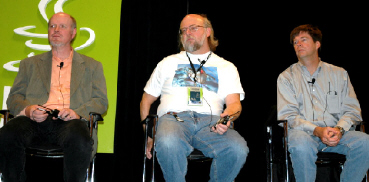The future of Java, part 1

"I would love to tinker with the Java language, but that’s not where I feel the pain now," said Java creator James Gosling during an early morning JavaOne session. He, along with Tim Bray, John Fowler and Simon Phipps, discussed the future of Java and applications development this morning at JavaOne. The pain point is the complexity of building applications, and for the last few years Gosling has been focused on developer tools. "Making complex things more approachable will be the central theme for a decade," Gosling added.

Sun's Tim Bray, James Gosling, John Fowler early in the morning at JavaOne
Tim Bray, one of the creators of XML and director of Web technologies at Sun, is looking forward to having dynamic (scripting) languages working on top of Java. "Java is not a good language for scripting,” Bray said. Where J2EE loses a deal, it’s not to the august competition, but to LAMP, which is easier to build with but lacks the threading and memory management of the Java language. It should be able to work with Perl, Python and Ruby."
Bray told me that the Coyote project for NetBeans has modules for Jython and Groovy, with features like code coloring and auto servelet generation. "It's a good proof of concept and it will convince people of the virtues of generalizing works in NetBeans," Bray said. J2SE 6.0 (now Java Standard Edition 6) will include the Mozilla Rhino JavaScript engine. However, a Javascript debugger is not in the works. "That [having a Javascript debugger] is almost unfixable," Gosling said. Bray added that while Javascript is the worst case, languages such as Python and Jython will have full debugger. "All of the magic in the Java world is at JVM level, where all the debugging mechanisms exist," he said.
There was also a bit of dialog about the Java development tools versus Microsoft’s Visual Studio .Net. "Visual Studio is great but it has no competition...it’s what the plantation owners have to offer and you have to pay for it," Bray said. "On Java, Eclipse, NetBeans, and Oracle are bashing each other, and I suspect the intense competition is going to end up being a more productive source of innovation in the development tool market."
Fowler, executive VP of network systems, talked about reaching developers with a super fast, Solaris 10 Opteron system bundled with development tools and support for $29.95 (why not $30?) per month for a three-year subscription. You can get one of these Sun Ultra 20 Workstations for $895 without the support services. The low cost system is part of Sun's strategy to get its software and tools in the hands of as many developers as possible around the world. "The volume has only just begun," Fowler said. Sun's strategy isn't to dominate one huge market space, such as the U.S. or Japan, but to get a fair share of lots of smaller markets that don't necessarily have preconceived notions about how to buy software and from whom.
Bray offered a prediction, which Gosling agreed with, that at JavaOne next year a major topic would be parallelizing applications. Doing parallelism is easier in Java than pretty much anything else, Gosling said, but some forms of it are extremely difficult, such as making large numeric data sets run fast. "Parallelism will be a grand challenge for next few years, from the JVM to the tools," Gosling said.
Tomorrow at JavaOne I'll be at the session headlined by Gosling, "Java Technology Contributions for the Next Decade." Perhaps some more revelations to come...
Update 4:08 PM PST 6/29/05: Stephen Shankland interviews Gosling about Java past and future...